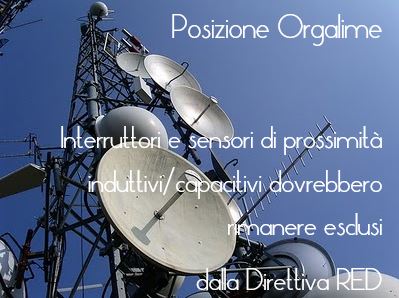Informazione tecnica HSE / 25 ° anno
/ Documenti disponibili:
45.705
/ Documenti scaricati: 34.758.784
/ Documenti scaricati: 34.758.784

Posizione Orgalime 29.06.2017
Il 13 Giugno 2017 è entrata pienamente in vigore la nuova Direttiva 2014/53/UE RED (recepita in Italia dal D.lgs. 22 giugno 2016 n. 128) che ha sostituito la Direttiva 1999/5/CE R&TTE.
Tuttavia, la Commissione europea, gli Stati membri ei rappresentanti del settore stanno discutrrensdo ancora problemi specifici di applicazione, che sono stati esaminati dalla prima versione della Guida RED e sono soggetti ad ulteriori analisi.
Tra questi temi, è stata posta la domanda se "interruttori e sensori di prossimità induttivi e capacitivi "dovrebbero rientrare nell'ambito della RED.
Fino ad ora, interruttori di prossimità e sensori erano coperti dalla direttiva EMC 2014/30/UE sulla compatibilità elettromagnetica (EMCD) e non dalla direttiva 1999/5/CE relativa alle apparecchiature terminali di radiotelefonia (R&TTE), in quanto essi non soddisfacevano la definizione di "apparecchi radio".
Per gli interruttori e sensori di prossimità, gli standard di prodotto IEC/CENELEC 60947-5-2, 60947-5-3 e 60947-5-7 sui dispositivi a bassa tensione e sui dispositivi di controllo, hanno offerto la presunzione di conformità con la pubblicazione nella Gazzetta ufficiale dell'Unione Europea (OJEU) alla EMCD per circa 25 anni.
Gli interruttori e i sensori di prossimità utilizzano un campo magnetico per rilevare oggetti (interruttori induttivi) o un campo elettrico (sensori capacitivi). Gli interruttori e sensori sono stati usati per diversi decenni in un numero estremamente ampio di applicazioni industriali come per esempio nell'automazione industriale. Nel 2016 circa 30 milioni di interruttori di prossimità e sensori sono stati venduti da parte europea Produttori nel mercato europeo con un fatturato di circa 578 milioni di euro.
Orgalime ritiene che siano adeguatamente coperti dai requisiti della direttiva sulla compatibilità elettromagnetica (EMCD) e la loro tecnologia non li spinge a rientrare nell'ambito della direttiva sulle apparecchiature radio (RED).
Inductive and capacitive proximity switches and sensors should remain outside the scope of the Radio Equipment Directive
Orgalime comments to the European Commission on the implementation of Directive 2014/53/EU on the making available on the market of radio equipment
Brussels, 29 giugno 2017
Proximity switches and sensors either use a magnetic field to detect objects (inductive switches) or an electrical field (capacitive switches). The switches and sensors have been used for several decades in an extremely large number of industrial applications as for example in the automation industry. In 2016 approximately 30 million proximity switches and sensors were sold by European manufacturers into the European market with a turnover of approximately 578 million euros.
Orgalime believes that they are appropriately covered by the requirements of the electromagnetic compatibility directive (EMCD) and their technology does not cause them to fall under the scope of the Radio Equipment Directive (RED).
We believe the European Commission’s advice to Member States and European Standards Organisations should follow the interpretation and market practice that has supported a very dynamic sector successfully thriving for over 25 years without safety issues or problems for the radio spectrum.
Directive 2014/53/EU on Radio Equipment (RED) has been applicable since 13 June 2016. However, the European Commission, Member States and industry representatives are still discussing specific application issues that were left outside the first version of the RED Guide and are subject to further analysis.
Among these issues, the question was raised whether “inductive and capacitive proximity switches and sensors” should fall within the scope of the RED. Until now, proximity switches and sensors were covered by the EMC Directive 2014/30/EU on Electromagnetic Compatibility (EMCD) and not the Directive 1999/5/EC on Radio & Telecommunication Terminal Equipment (R&TTE), since they did not satisfy the latter's definition of "radio equipment". For proximity switches and sensors, the product standards IEC/CENELEC 60947-5-2, 60947-5-3 and 60947-5-7 on low-voltage switchgear and control-gear has offered presumption of conformity further to its listing in the Official Journal of the European Union (OJEU) under the EMCD for approximately 25 years.
Inductive and capacitive proximity switches and sensors do not fall within the above definitions and consequently within the scope of the RED, since they do not intentionally transmit and/or receive electromagnetic waves but electrical magnetic fields. Note that electrical and magnetic fields are different in the nature from electromagnetic waves.
While the electromagnetic waves continue to propagate in space also after the transmitter is turned off, electrical and electromagnetic fields do not propagate in space and disappear immediately when the current or voltage that generates the fields are turned off. The inductive and capacitive sensors do intentionally generate magnetic or electrical fields, but do not intentionally generate or receive electromagnetic waves.
As a consequence, proximity switches and sensors cannot be qualified as radio equipment in the meaning of the RED. They remain within the scope of the EMCD.
...
1. INTRODUCTION
2. WHAT ARE INDUCTIVE AND CAPACITIVE SWITCHES AND SENSORS?
3. DEFINITIONS IN THE RED
4. CLASSIFICATION OF INDUCTIVE AND CAPACITIVE PROXIMITY SWITCHES AND SENSORS
5. CONCLUSION
Normativa correlata:
Nuova Direttiva R&TTE 2014/53/UE (Direttiva RED)
Decreto Legislativo 22 giugno 2016 n. 128
Nuova Direttiva EMC 2014/30/UE

Report 47 del 25/11/2016 N.28 A12/1509/16 Spagna
Approfondimento tecnico: Calzature di sicurezza
Il prodotto, di marca Security Line, modello “ne...

Normativa tecnica relativa ai monopattini a propulsione prevalentemente elettrica.
(GU n.202 del 30.08.2022)
Entrata in ...

ID 1961 | 14.03.2017 / In allegato
EN ISO 14159
Sicurezza del macchinario
Requisiti relativi all'igiene per la progettazione d...
Testata editoriale iscritta al n. 22/2024 del registro periodici della cancelleria del Tribunale di Perugia in data 19.11.2024